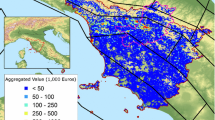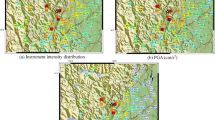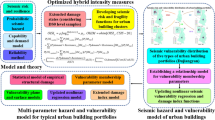Abstract
The seismic risk assessment of spatially distributed assets requires a seismic hazard that considers the spatial correlations of earthquake intensity measures (IMs). Several spatial correlation models have been developed to address this concern, but the majority of existing models are based on the hypothesis of isotropy. Recent investigations revealed that the assumption of isotropy is not generally valid, and the anisotropy condition should be taken into account when considering the spatial correlations of earthquake IMs. On the other hand, it is necessary to investigate the significance of the inclusion of anisotropy in seismic risk and resiliency assessment. The main objective of the current study is to address this issue using three different spatial correlation models. Two of them are based on the linear model of coregionalization method, which describes the spatial correlation of earthquake IMs from the isotropy point of view. The third model is based on the latent dimensions method, which can take the anisotropy into account. The results of the current study reveal that the ignorance of anisotropy of spatial correlations of earthquake IMs causes unrealistic loss estimation and leads to inaccurate resilience assessment of spatially distributed assets and systems. It is demonstrated specifically that the isotropic models generally overestimate the infrequent loss values which is on the safe side, but underestimate the frequent loss values that is non-conservative.


















Similar content being viewed by others
Data availability
The data will be available as requested.
Code availability
The utilized codes will be available as requested.
References
Abbasnejadfard M, Bastami M, Fallah A (2020) Investigation of anisotropic spatial correlations of intra-event residuals of multiple earthquake intensity measures using latent dimensions method. Geophys J Int 222:1449–1469. https://doi.org/10.1093/gji/ggaa255
Apanasovich TV, Genton MG (2010) Cross-covariance functions for multivariate random fields based on latent dimensions. Biometrika 97:15–30. https://doi.org/10.1093/biomet/asp078
Bastami M (2007) Seismic reliability of power supply system based on probabilistic approach. Kobe University, Japan
Bastami M, Kowsari M (2014) Seismicity and seismic hazard assessment for greater Tehran region using Gumbel first asymptotic distribution. Struct Eng Mech 49:355–372
Boore DM, Gibbs JF, Joyner WB et al (2003) Estimated ground motion from the 1994 Northridge, California, earthquake at the site of the interstate 10 and La Cienega Boulevard bridge collapse, West Los Angeles, California. Bull Seismol Soc Am 93:2737–2751. https://doi.org/10.1785/0120020197
Bruneau M, Chang SE, Eguchi RT et al (2003) A framework to quantitatively assess and enhance the seismic resilience of communities. Earthq Spectra 19:733–752. https://doi.org/10.1193/1.1623497
Campbell KW, Bozorgnia Y (2014) NGA-West2 ground motion model for the average horizontal components of PGA, PGV, and 5% damped linear acceleration response spectra. Earthq Spectra 30:1087–1114. https://doi.org/10.1193/062913EQS175M
Cressie N (1993) Statistics for spatial data: Wiley series in probability and mathematical statistics. John Wiley & Sons
Crowley H, Bommer JJ (2006) Modelling seismic hazard in earthquake loss models with spatially distributed exposure. Bull Earthq Eng 4:249–273. https://doi.org/10.1007/s10518-006-9009-y
Du W, Wang G (2013) Intra-event spatial correlations for cumulative absolute velocity, arias intensity, and spectral accelerations based on regional site conditions. Bull Seismol Soc Am 103:1117–1129. https://doi.org/10.1785/0120120185
Esposito S, Iervolino I (2011) PGA and PGV spatial correlation models based on European multievent datasets. Bull Seismol Soc Am 101:2532–2541
Esposito S, Iervolino I (2012) Spatial correlation of spectral acceleration in European data. Bull Seismol Soc Am 102:2781–2788. https://doi.org/10.1785/0120120068
FEMA (2015) Multi-hazard loss estimation methodology, earthquake model, Hazus–MH 2.1: technical manual. Federal Emergency Management Agency, Washington
Garakaninezhad A, Bastami M (2017) A novel spatial correlation model based on anisotropy of earthquake ground-motion intensity. Bull Seismol Soc Am 107:2809–2820. https://doi.org/10.1785/0120160367
Garakaninezhad A, Bastami M (2019) Intra-event spatial correlation model for the vertical component of response spectral accelerations. J Seismol 23:853–867
Goda K, Atkinson GM (2009) Probabilistic characterization of spatially correlated response spectra for earthquakes in Japan. Bull Seismol Soc Am 99:3003–3020
Goda K, Hong HP (2008a) Spatial correlation of peak ground motions and response spectra. Bull Seismol Soc Am 98:354–365. https://doi.org/10.1785/0120070078
Goda K, Hong HP (2008b) Estimation of seismic loss for spatially distributed buildings. Earthq Spectra 24:889–910. https://doi.org/10.1193/1.2983654
Jayaram N (2010) Probabilistic seismic lifeline risk assessment using efficient sampling and data reduction techniques. Stanford University
Jayaram N, Baker JW (2008) Statistical tests of the joint distribution of spectral acceleration values. Bull Seismol Soc Am 98:2231–2243. https://doi.org/10.1785/0120070208
Jayaram N, Baker JW (2009) Correlation model for spatially distributed ground-motion intensities. Earthq Eng Struct Dyn 38:1687–1708
Lee R, Kiremidjian AS (2007) Uncertainty and correlation for loss assessment of spatially distributed systems. Earthq Spectra 23:753–770
Loth C, Baker JW (2013) A spatial cross-correlation model of spectral accelerations at multiple periods. Earthq Eng Struct Dyn 42:397–417
Park J, Bazzurro P, Baker JW (2007) Modeling spatial correlation of ground motion intensity measures for regional seismic hazard and portfolio loss estimation. Appl Stat Probab Civ Eng 1–8
Sadeghi M, Ghafory-Ashtiany M, Pakdel-Lahiji N (2015) Developing seismic vulnerability curves for typical Iranian buildings. Proc Inst Mech Eng Part O J Risk Reliab 229:627–640
Schiappapietra E, Douglas J (2020) Modelling the spatial correlation of earthquake ground motion: Insights from the literature, data from the 2016–2017 central Italy earthquake sequence and ground-motion simulations. Earth Sci Rev 203:103139. https://doi.org/10.1016/j.earscirev.2020.103139
Schiappapietra E, Smerzini C (2021) Spatial correlation of broadband earthquake ground motion in Norcia (Central Italy) from physics-based simulations. Bull Earthq Eng. https://doi.org/10.1007/s10518-021-01160-7
Silva V, Crowley H, Pagani M et al (2014) Development of the openquake engine, the global earthquake model’s open-source software for seismic risk assessment. Nat Hazards 72:1409–1427
Stergiou EC, Kiremidjian AS (2010) Risk assessment of transportation systems with network functionality losses. Struct Infrastruct Eng 6:111–125. https://doi.org/10.1080/15732470802663839
Tavakoli B, Ghafory-Ashtiany M (1999) Seismic hazard assessment of Iran. Ann Geophys. https://doi.org/10.4401/ag-3781
Wang G, Du W (2013) Spatial cross-correlation models for vector intensity measures (PGA, Ia, PGV, and SAs) considering regional site conditions. Bull Seismol Soc Am 103:3189–3204. https://doi.org/10.1785/0120130061
Wang M, Takada T (2005) Macrospatial correlation model of seismic ground motions. Earthq Spectra 21:1137–1156
Weatherill GA, Silva V, Crowley H, Bazzurro P (2015) Exploring the impact of spatial correlations and uncertainties for portfolio analysis in probabilistic seismic loss. Bulletin of Earthquake Engineering 13(4):957–981
Acknowledgements
The authors would like to acknowledge the International Institute of Earthquake Engineering and Seismology (IIEES) for the provided supports.
Funding
This work was supported by International Institute of Earthquake Engineering and Seismology (IIEES) under grant number 7552.
Author information
Authors and Affiliations
Contributions
Conceptualization: [MA, MB], Methodology: [MA], Formal analysis and investigation: [MA], Writing—original draft preparation: [MA]; Writing—review and editing: [MA, MB, AG], Funding acquisition: [MB], Resources: [MB], Supervision: [MB, AF], Project administration [MB], Software [MA], Visualization [MA].
Corresponding author
Ethics declarations
Conflicts of interest
The authors have no conflicts of interest to declare that are relevant to the content of this article.
Additional information
Publisher's Note
Springer Nature remains neutral with regard to jurisdictional claims in published maps and institutional affiliations.
Rights and permissions
About this article
Cite this article
Abbasnejadfard, M., Bastami, M., Fallah, A. et al. Analyzing the effect of anisotropic spatial correlations of earthquake intensity measures on the result of seismic risk and resilience assessment of the portfolio of buildings and infrastructure systems. Bull Earthquake Eng 19, 5791–5817 (2021). https://doi.org/10.1007/s10518-021-01203-z
Received:
Accepted:
Published:
Issue Date:
DOI: https://doi.org/10.1007/s10518-021-01203-z




